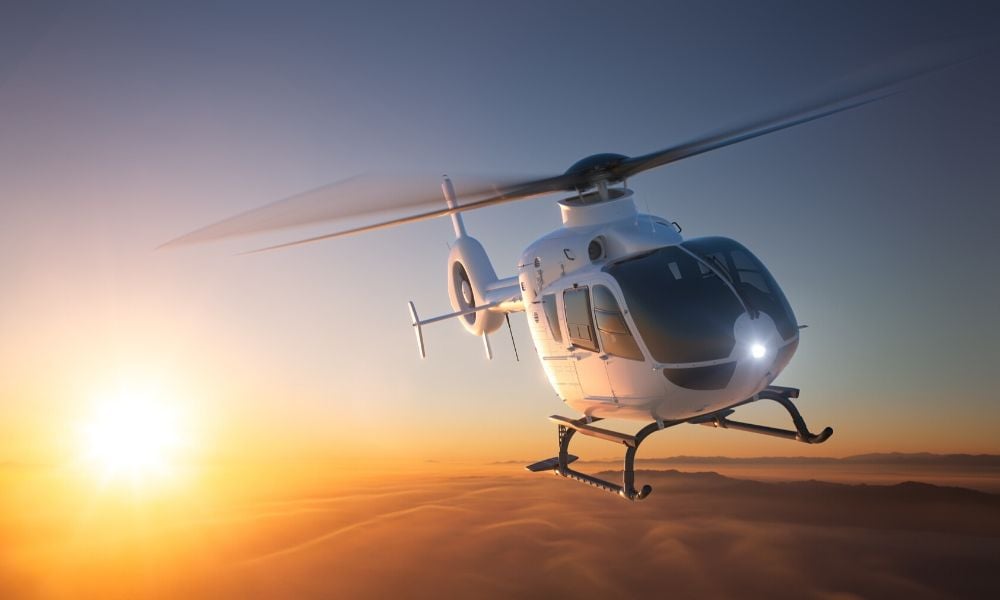
In the modern age, we take for granted many amazing feats of mechanical ingenuity accomplished by inventors in the past. One of these great inventions is the helicopter. But where did the idea of helicopters come from? How did we get to the functioning helicopters we see today? Here, we present a brief history of the development of these incredible machines.
When Was the Helicopter Invented?
We can trace the earliest example of a human-made device resembling a helicopter back to ancient China, where small toys called bamboo-copters came to fruition around 400 BC. They flew up in the air when spun quickly between the hands using a rotor system design that could generate a small amount of lift. When these toys made their way to Europe in the 1400s, Leonardo da Vinci created his famous theoretical sketches for helical flying machines after seeing them. However, no one ever physically built these designs. Much later in 1870, Alphonse Pénaud fashioned a helicopter model powered by rubber bands. Though these designs were far from rideable, they would go on to serve as inspiration for future helicopter pioneers.
Fledgling Flight
Ancient ideas laid the groundwork for later attempts at successful powered helicopter flight and human's persistent quest to conquer the vertical dimension of our atmosphere. Moving beyond these early musings, pioneers went on to construct full-scale prototypes of a fixed wing aircraft.
The influence of Sir George Cayley played a significant role in shaping the first practical helicopter. Cayley's notable concepts included the recognition of lift, drag, thrust, and weight forces in helicopter flying. He also designed models resembling modern helicopters with a rotating wing providing lift.
After an explanation of flight principles by Sir George Cayley in 1843, numerous inventors in Europe tried their hand at the dilemma of vertical flight. The journey toward modern helicopters saw contributions from visionaries like Louis and Jacques Breguet, who in 1907 made a machine that could hover two feet in the air while tethered to the ground. Paul Cornu also made a double-rotor machine that could fly but without steering capabilities that same year.
Early Success
Seeking to gain a way to direct flight, Jacob Ellehammer implemented a cyclic pitch control system in his helicopter in 1912, though his air times and free flight were still minimal. However, Etienne Oehmichen created a helicopter with main rotor blades facing sideways, rotors that faced upwards for lift, and then later added an anti torque tail rotor. As such, it was Oehmichen who was able to set records for distance traveled in 1922, as one could pilot his helicopters and carry passengers.
In Germany in 1936, just before World War II, Henrich Focke and Gerd Achgelis made an even more successful helicopter that had two counter-rotating rotors and cyclic pitch control. Due to how the rotors moved in opposite directions, the helicopter did not tend to turn in one direction due to torque, which was a major discovery.
The Modern Design
Centuries later, dreamers still chased the vision of vertical takeoff. Finally, after so many iterations and contributions, Igor Sikorsky invented the modern design of most helicopters with a rotor head and main rotor blades seen today. As a child, his parents exposed him to the drawings of da Vinci and encouraged him to pursue science. Following this course, he became an engineer focused on the design of aircraft.
For many years, he produced successful planes before he turned his attention toward single rotor helicopters. Once he managed to create the first successful helicopter, he left an unmistakable mark in the helicopter industry. Starting test flights in 1939, pilots began training, including the first female helicopter pilot. Sikorsky's helicopter was ready for larger production by 1942. Sikorsky helicopters featured a primary three-blade rotor and a smaller tail rotor, and the collective pitch (the angle) of the main rotor directed it. The modern helicopter was born.
Shortly after, in 1944 at the young age of 19, Stanley Hiller Jr. created the first coaxial helicopter to fly successfully in the United States.
Helicopter development continued rapidly, with innovations in engine power and control systems that allowed for safer, more efficient flight. Today, the ability of helicopters to sustain horizontal flight, hover, and perform vertical takeoffs makes them indispensable in various fields.
Discovering the history of the helicopter is enough to make you want to get flying yourself. If you would like to learn more about becoming a helicopter pilot, contact Hillsboro Heli Academy so you can take your first steps in the process.
